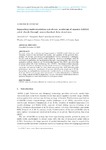Mostrar o rexistro simple do ítem
Supporting multi-resolution out-of-core rendering of massive LiDAR point clouds through non-redundant data structures
| dc.contributor.author | Deibe, David | |
| dc.contributor.author | Amor, Margarita | |
| dc.contributor.author | Doallo, Ramón | |
| dc.date.accessioned | 2023-12-15T12:33:03Z | |
| dc.date.available | 2023-12-15T12:33:03Z | |
| dc.date.issued | 2019-03 | |
| dc.identifier.citation | David Deibe, Margarita Amor & Ramón Doallo (2019) Supporting multi-resolution out-of-core rendering of massive LiDAR point clouds through non-redundant data structures, International Journal of Geographical Information Science, 33:3, 593-617, DOI: 10.1080/13658816.2018.1549734 | es_ES |
| dc.identifier.issn | 1365-8824 | |
| dc.identifier.uri | http://hdl.handle.net/2183/34519 | |
| dc.description | This is an Accepted Manuscript of an article published by Taylor & Francis in INTERNATIONAL JOURNAL OF GEOGRAPHICAL INFORMATION SCIENCE on 28 Nov 2018, available at: https://doi.org/10.1080/13658816.2018.1549734 | es_ES |
| dc.description.abstract | [Abstract]: In recent years, the evolution and improvement of LiDAR (Light Detection and Ranging) hardware has increased the quality and quantity of the gathered data, making the storage, processing and management thereof particularly challenging. In this work we present a novel, multi-resolution, out-of-core technique, used for web-based visualization and implemented through a non-redundant, data point organization method, which we call Hierarchically Layered Tiles (HLT), and a tree-like structure called Tile Grid Partitioning Tree (TGPT). The design of these elements is mainly focused on attaining very low levels of memory consumption, disk storage usage and network traffic on both, client and server-side, while delivering high-performance interactive visualization of massive LiDAR point clouds (up to 28 billion points) on multiplatform environments (mobile devices or desktop computers). HLT and TGPT were incorporated and tested in ViLMA (Visualization for LiDAR data using a Multi-resolution Approach), our own web-based visualization software specially designed to work with massive LiDAR point clouds. | es_ES |
| dc.description.sponsorship | This research was supported by Xunta de Galicia under the Consolidation Programme of Competitive Reference Groups, co-founded by ERDF funds from the EU [Ref. ED431C 2017/04]; Consolidation Programme of Competitive Research Units, co-founded by ERDF funds from the EU [Ref. R2016/037]; Xunta de Galicia (Centro Singular de Investigación de Galicia accreditation 2016/2019) and the European Union (European Regional Development Fund, ERDF) under Grant [Ref. ED431G/01]; and the Ministry of Economy and Competitiveness of Spain and ERDF funds from the EU [TIN2016-75845-P]. | es_ES |
| dc.description.sponsorship | Xunta de Galicia; ED431C 2017/04 | es_ES |
| dc.description.sponsorship | Xunta de Galicia; R2016/037 | es_ES |
| dc.description.sponsorship | Xunta de Galicia; ED431G/01 | es_ES |
| dc.language.iso | eng | es_ES |
| dc.publisher | Taylor & Francis Group | es_ES |
| dc.relation | info:eu-repo/grantAgreement/AEI/Plan Estatal de Investigación Científica y Técnica y de Innovación 2013-2016/TIN2016-75845-P/ES/NUEVOS DESAFIOS EN COMPUTACION DE ALTAS PRESTACIONES: DESDE ARQUITECTURAS HASTA APLICACIONES (II) | es_ES |
| dc.relation.uri | https://doi.org/10.1080/13658816.2018.1549734 | es_ES |
| dc.rights | Atribución-NoComercial-SinDerivadas 3.0 España | es_ES |
| dc.rights.uri | http://creativecommons.org/licenses/by-nc-nd/3.0/es/ | * |
| dc.subject | LiDAR | es_ES |
| dc.subject | Web-visualization | es_ES |
| dc.subject | Efficient data structures | es_ES |
| dc.subject | Multi-resolution | es_ES |
| dc.subject | Out-of-core | es_ES |
| dc.title | Supporting multi-resolution out-of-core rendering of massive LiDAR point clouds through non-redundant data structures | es_ES |
| dc.type | info:eu-repo/semantics/article | es_ES |
| dc.rights.access | info:eu-repo/semantics/openAccess | es_ES |
| UDC.journalTitle | International Journal of Geographical Information Science | es_ES |
| UDC.volume | 33 | es_ES |
| UDC.issue | 3 | es_ES |
| UDC.startPage | 593 | es_ES |
| UDC.endPage | 617 | es_ES |
Ficheiros no ítem
Este ítem aparece na(s) seguinte(s) colección(s)
-
GI-GAC - Artigos [181]






